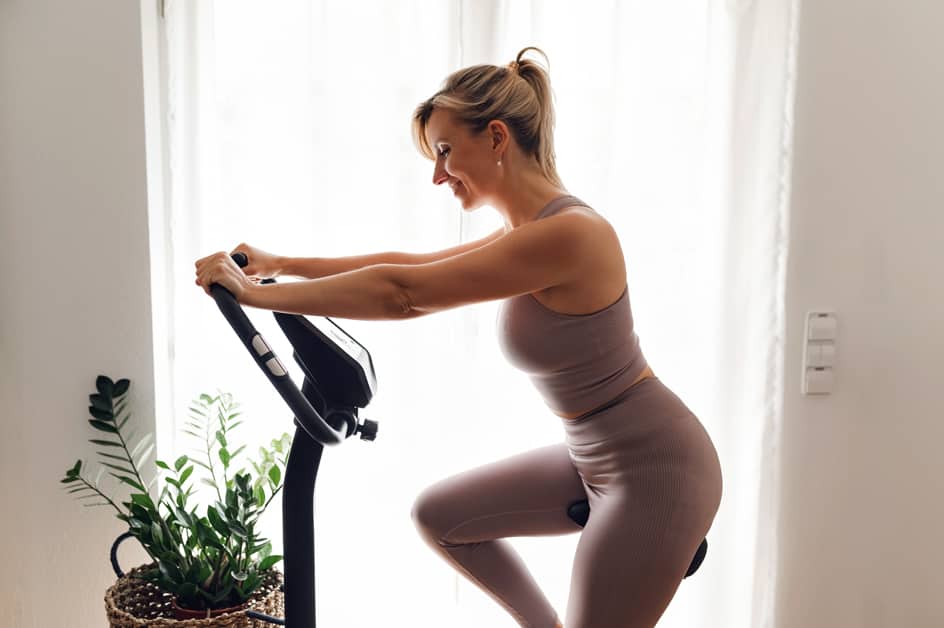Introduction
The choice between a stationary bike and a recumbent bike for exercise can be hard for those with knee pain. Both have their advantages and disadvantages. This guide will explore the difference between the two and their benefits for those with knee pain. We’ll provide you with enough info, so you can make an informed decision on which type of exercise is best for your unique situation.
Benefits of Stationary Bikes
Stationary bikes provide a plethora of advantages to those who endure knee pain. Low-impact exercise can help reduce pain, as well as improve joint mobility, coordination and balance. Plus, they require less setup than recumbent bikes, making them more accessible.
Let’s explore the benefits of using a stationary bike further!
Low Impact
Stationary bikes, also known as exercise bikes or spinning bikes, are popular indoor cycling machines. They offer many advantages over other types of fitness equipment.
For instance, riding a stationary bike has low-impact movement, which makes it easy on your joints, ankles and feet. It’s perfect for those with joint issues or seniors who want to stay in shape. Furthermore, since you’re seated, it puts less stress on your lower body, allowing you to ride for longer periods if needed.
Adjustable Resistance
A stationary bike’s adjustable resistance is a great feature. It lets you choose different levels when pedaling. Depending on the type of bike, there can be manual or automatic adjustments.
Knee pain sufferers benefit from adjustable resistance. They don’t have to strain their joints or knees too much to start. Furthermore, they can work out different muscles by switching settings. This makes workouts more efficient and with less impact on the body.
When buying a stationary bike, look for one that has easy-to-see settings. Also, it should have smooth transitions between settings. That way, your system won’t be shocked with sudden intensity changes.
Improved Cardiovascular Health
Stationary biking is a great workout choice! It can increase your heart rate, lower your blood pressure, and help with medical conditions like diabetes, obesity, and arthritis. Plus, it’s a great way to burn calories and build muscle.
Most stationary bikes have adjustable settings – like resistance levels or handlebars – to suit different users or their training goals. The smooth motion of the pedals is easier on the joints than other cycling workouts.
Monitoring your heart rate is important when riding a stationary bike. Most recumbent or upright bikes come with a pulse monitor to track your progress.
Benefits of Recumbent Bikes
Exercising is key for great health. But for those with knee pain, it can be challenging to find the right workout. That’s where recumbent bikes come in! They have an upright design and comfy seating, making them a great choice for those with knee pain.
Here, we’ll look at the benefits of recumbent bikes and how they can help ease your knee pain:
Low Impact
Recumbent bikes are designed for a less straining ride on the knee joints. The reclined seat and forward seating helps keep the knees bent, which reduces the pressure and stress on them. This low-impact option is not only comfortable, but also provides great cardiovascular benefits.
It also encourages good posture. The reclined position gives an open chest area and a healthy posture which helps avoid back pain and other health issues.
This type of stationary bike has adjustable handle height and seat, which makes it suitable for all fitness levels.
Adjustable Resistance
Stationary and recumbent bikes have adjustable resistance. This lets you change the difficulty of pedaling. Set it low for warm-up. Or, higher to get bursts of energy.
High resistance helps with weight loss and muscle building. Change the intensity during your session. This evens out stress throughout your body.
Recumbent bikes are comfy due to their adjustable positioning and lumbar support. Plus, less shock travels up your spine. They also have cushioned seating and back support. Perfect for controlled exercise from an upright position.
Improved Cardiovascular Health
Recumbent exercise bikes provide a comfy position for stationary cyclists. Unlike upright bikes, the reclined position takes pressure off the lower back. This is great for people with back pain as the bike evenly distributes weight between back, buttocks and arms.
Recumbent bikes provide support for head, neck and upper body. This allows users to relax while exercising. The increased comfort leads to better breathing, higher heart rate levels and quicker oxygenation of blood cells. This translates into improved cardiovascular health. In addition, users tend to experience fewer cramps in their legs than those who use an upright exercise bike.
Comparison of Stationary Bikes and Recumbent Bikes
Relieving knee pain? Stationary and recumbent bikes both provide low-impact aerobic exercise. It can be great for strengthening knee joints. But, the two types of exercise bikes have subtle differences. In this article, we’ll compare the main features of each. That way, you can decide which is best for relieving your knee pain.
Low Impact
Low impact exercise? Stationary and recumbent bikes are great! The main difference? A stationary bike keeps feet and legs in the same position, while a recumbent bike lets you move your knees and hips. Easier on the knees!
Stationary bikes have adjustable handlebars and resistance features, so they’re great for beginners and pros alike. They take stress off arms, wrists, and shoulders.
Recumbent bikes? They offer even lower impact! They have a padded backrest, and let you pedal at a comfortable angle. This puts less strain on leg muscles, making them ideal for those with knee issues. Plus, metrics like speed and power are monitored for safe movements.
Adjustable Resistance
When it comes to resistance, stationary bikes have a knob that lets you adjust the difficulty level, from 1 (easiest) to 10 (hardest). This way, users can fit the bike to their fitness level and goals.
Recumbent bikes offer adjustable resistance too. Depending on the model, this can be controlled electronically or mechanically. Electric recumbent bikes have settings like “hill” or “power” and are usually quieter, with up to 16 levels. They are more expensive, though. Mechanical recumbent bikes don’t show resistance levels, but they are cheaper.
Both styles of bikes give users the chance to tailor their routine, within reason, without putting too much stress on their joints.
Improved Cardiovascular Health
Stationary and recumbent bikes are great for aerobic exercise and heart health.
- Stationary, or upright, bikes provide a traditional cycling experience. You can adjust your body position, but keep your feet and hands in the same spot while pedalling.
- Recumbent bikes also offer exercise, but at a lower-impact level. These bikes let you recline and have your legs extend in front of you at a more relaxed angle. This is great for larger individuals or those with limited mobility.
Both types of exercise bikes can be beneficial. However, if you suffer from knee pain or want to target knee strengthening, a recumbent bike is better. It is less likely to cause joint problems.
Pros and Cons of Stationary Bikes and Recumbent Bikes
A discussion has been occurring for a while, pondering which type of bike is better for knee pain: stationary or recumbent? Both bikes have their own ups and downs. It’s imperative to think about these pros and cons before settling on a choice. Let’s analyze the positive and negative aspects of the stationary and recumbent bikes:
- Stationary Bike
- Recumbent Bike
Stationary Bikes
Stationary bikes are awesome for cardio workouts! They let you burn fat and stay fit, with a low-impact, comfortable ride. Plus, you have control over the intensity.
Pros:
- Low impact & comfortable.
- Can control intensity with the resistance settings.
- Ideal for interval training – increase or decrease resistance as needed.
- Pedal at your own pace, great for beginners.
- Cardio workout without stressing joints – good for those with joint pain or injuries.
Cons:
- Some models don’t have heart-rate monitors.
- Boredom can set in quickly. This can lead to less effective workouts if no one is watching.
Pros
Stationary bikes make a great choice for low-impact exercise. They are perfect for those who want to keep fit without putting too much strain on their body. You don’t have to go outside or spend money on gym classes. Plus, they are suitable for small homes.
Stationary bikes have more customizing options than recumbent bikes. You can adjust handlebars, seats and tension levels to fit your needs and goals. Extras like heart rate monitors and adjustable pedals add comfort and convenience. Moreover, some stationary bikes let you track speed, distance and calories burned on their display console – making it easy to measure your progress.
Cons
Stationary and recumbent bikes offer various benefits, but there are also a few drawbacks.
- For stationary bikes, the major issue is discomfort. Their upright position can lead to neck, shoulder and lower back strain. Plus, they take up more space than recumbent bikes and may not fit into smaller areas.
- Recumbent bikes have their own cons too. They’re low to the ground and have a footwork section that protrudes, making it hard for some riders to get on or off. Plus, they tend to require more floor space and are difficult to move.
Recumbent Bikes
Recumbent bikes are a great option for cyclists with knee pain. They’re designed for a reclining position, reducing pressure on the joint. Plus, they have lots of features like adjustable seats, upper body support, and backrests. And, they offer low-impact training with adjustable resistance.
But, they can be pricey. Budget models are available, but they’re typically bigger and heavier than upright bikes. Long distance riding isn’t ideal either, since they’re hard to transport. And, accessories like handlebar grips and straps may be hard to find.
Pros
Stationary Bikes:
- Joints get low impact exercise.
- Pedaling helps muscles stay strong.
Recumbent Bikes:
- More adjustable than traditional stationary bikes.
- Pressure on nerves is reduced by sitting with feet lower than heart. This can help to reduce knee pain.
Cons
Recumbent and stationary bikes are both great for low-impact exercise. But, there are some cons to consider before making a decision.
- Stationary bikes have limited adaptability. These machines usually have one type of resistance which won’t change as you get fitter.
- Recumbent bikes let you easily adjust the difficulty, by using the handles or an electronic console. Some recumbents have electronic displays and advanced features, like calorie tracking and heart rate monitors.
Another con to consider is adjustability. Most stationary bikes only adjust in height, but some recumbent models also let you adjust forwards and backwards. This gives riders more flexibility and comfort, so their knee pain won’t stop them from having an enjoyable ride.
Conclusion
It’s evident that both stationary and recumbent bikes have advantages for those with knee pain. But, the bike that fits an individual’s needs most depends on their physical abilities and level of comfort.
For a low-impact exercise option, a stationary bike is ideal because of its handlebars and low seated position. A recumbent bike is a better choice for those who need more support or plan to ride for longer periods in an upright position.
Both types of bikes can provide beneficial cardio exercise and strengthen leg muscles. Thus, one must assess which bike best meets their exercise goals and is comfortable.
Frequently Asked Questions
Q1: What is the difference between a stationary bike and a recumbent bike?
A1: A stationary bike is a type of exercise bike that does not move, while a recumbent bike is a type of exercise bike with a reclined seat and pedals placed in front of the rider.
Q2: Is a stationary bike or a recumbent bike better for knee pain?
A2: A recumbent bike is typically better for knee pain as it puts less strain on the joints.
Q3: Are there any other benefits of using a recumbent bike?
A3: Yes, a recumbent bike is also easier on the back and can be more comfortable for people with physical limitations.





